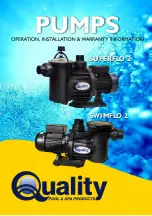
TYPICAL
MAXIMUM FOUNDATION GRADIENT
Figure 4
10mm(0.8°)
10mm(0.8°)
10mm(0.5°)
CONDENSATE DRAIN SIDE
4.4 MAXIMUM FOUNDATION GRADIENT
Note: Make sure that Condensate Drain side is not higher than the other side.
4.5 CONDENSATE DRAIN PIPING
DRAIN CONNECTION HOLE
DRAIN OUTLET
SNAP RING
DRAIN PIPE
Figure 5
≥
20mm
Note: Twist drain outlet into drain connection hole, sheathe drain pipe, lock in the
snap ring.
All conditioned air ductwork should be insulated to minimize
heating and cooling duct losses. Use a minimum of two (2) inches
of insulation with a vapor barrier. The outside ductwork must be
weatherproofed between the unit and the building.
When attaching ductwork to a horizontal unit, provide a flexible
watertight connection to prevent noise transmission from the unit to
the ducts. The flexible connection must be indoors and made out of
heavy canvas.
NOTE
Do not draw the canvas taut between the solid ducts.
4.6 DUCTWORK
Figure 6
UNIT DUCT FLANGE
FIELD DUCT
WEATHERPROOF THIS SEAM
UNIT EXTERIOR
5. ELECTRICAL WIRING
IMPORTANT: Upon completion of wiring check all electrical
connections, including factory wiring within the unit, make sure
all connections are tight. Replace and secure all electrical box
covers and access doors before leaving the unit or turning on
the power to the unit.
■
ELECTRICAL POWER
It is important that proper electrical power be available for the
unit. Voltage variation should remain within the limits stamped
on the unit nameplate.
■
DISCONNECT SWITCH
Provide an approved weatherproof disconnect either on the side
of the unit or within close proximity and within sight of the unit.
■
OVER CURRENT PROTECTION
The branch circuit feeding the unit must be protected as shown
on the unit rating plate.
■
POWER WIRING
The power supply lines must be run in weather tight conduit
to the disconnect and into the bottom of the unit control
box. Provide strain relief for all conduit with suitable connectors.
Provide flexible conduit supports whenever vibration transmision
may cause a noise problem within the building structure. Be sure
all connections are made tight.
■
CONTROL WIRING (CLASS II)
Low voltage control wiring should not be run in conduit with
power wiring unless Class 1 wire of proper voltage rating is used.
Make connections as shown on the unit wiring diagram. Do not
short thermostat wires since this will damage the control-
transformer.
Suggestion: thermostat choose Non-programmed eletrical
thermostat series such as
1. Honeywell, TH5220D
2. Hailin, A3211
I&O manual
4






































